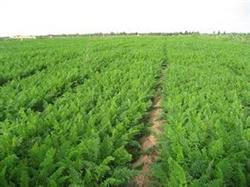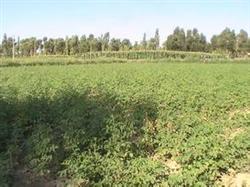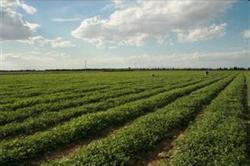Glycyrrhiza uralensis seedlings transplanting method

The glycyrrhizic acid contained in licorice is 200 ~ 300 times sweeter than sucrose, which is the best natural sweetener found so far. China has exported a large number of licorice and its extract to Europe, the United States and Southeast Asian countries, and it has become a major export medicinal material for earning foreign exchange. Due to the increasing consumption at home and abroad, the resources of wild licorice are becoming more and more exhausted. Therefore, it is necessary to carry out artificial cultivation of licorice. Licorice is mainly distributed in the "three north" areas of China, and it is not strict with the soil. It likes to grow in weakly alkaline sandy land, grassland, sand, riverbank, desert and semi-desert environment. The black land introduced to grain producing areas can also have high yield and good quality. Artificial planting of licorice is best to raise seedlings and transplant, that is, first raise seedlings in the nursery for one year, and then transfer the seedlings to the field in autumn or spring of the following year. Raising one mu of seedlings can transplant 5 mu-7 mu, which is higher than that of direct sowing in the field and requires less labor for harvest. Licorice is best planted on land with fertile soil, loose texture, good drainage and rich in organic matter. 40cm should be deeply ploughed for soil preparation, and high-quality farm fertilizer 3m3 and 20kg diammonium phosphate should be applied per mu as base fertilizer. Then make a wide 65cm ridge to suppress the broadcast. Sowing and raising seedlings can be done in spring, summer and autumn. Autumn sowing takes place before the earth freezes. To plough out a wide 20cm ditch on the ridge surface, flatten it after the plough, step on the lattice manually, sow the seeds soaked with fungicide evenly on the ridge surface with a little gourd, cover the soil around 2cm, and then suppress it. Sowing 5kg-8kg per mu, if the soil moisture is good, the whole seedling can be produced in about 10 days. In order to prevent grass damage, the herbicide trifluralin can be sprayed on the ridge before sowing, the dosage per mu should be 5% of the reduced dosage per mu, and the seeds should be sown every 6 days after spraying. After licorice seedlings are unearthed, they should often go to the field to see if there are dead seedlings. If so, 100g methyl topiramate powder, 250g urea and water 50kg per mu, fully dissolved and sprayed on the leaves of seedlings, can effectively prevent the death of seedlings. Lack of seedlings and broken ridges should be replanted as soon as possible. When licorice grows 4-6 true leaves, urea is applied once in ridges and furrows in combination with tillage, l0kg per mu. When the seedling grows to 10 leaves, you should shovel weeds frequently, and when the grass shortage is serious, you can spray 150g~200g per mu to catch clean. There are 100000 ~ 120000 seedlings per mu in the seedling field. When licorice grows to 15 true leaves, green insects may occur. Methamidophos l00g-200g is used to spray water per mu, and 100g omethoate is used to spray water for aphids. When two kinds of bugs occur at the same time, the two agents can be sprayed together. Licorice should be pulled out as soon as possible after sealing ridges, and stagnant water should be drained in time in the rainy season to prevent rotting roots. The yield of transplanting in autumn of that year was higher than that of the following spring. When transplanting, the stubble and transverse stem of 5cm should be left above the root Reed head, and the seedlings should not be cut and planted, and the overwintering buds and fibrous roots of the root Reed head should not be cut off. The root of Glycyrrhiza uralensis can be planted horizontally, obliquely or horizontally by ploughing l0cm deep. Plant distance 10cm, covering soil depth 10cm, pressing to preserve soil moisture. When planting 18000-22000 plants per mu, it is best to irrigate the roots once before freezing. Licorice can be harvested in the autumn of the second year after transplanting. In October, the licorice can be harvested with a plough, get rid of the soil, tie up into small handfuls according to different grades of soil roots and lateral roots, and dry them for sale. It can also be harvested before sprouting in the next spring. Due to the decrease of wild licorice resources year by year, the artificial planting of licorice has just started, the price is rising frequently, and the economic benefit is considerable.
- Prev

Seedling raising and transplanting technique of Glycyrrhiza uralensis
Licorice is an important medicinal material, with the strengthening of national ecological environment protection, the utilization of wild resources has been very limited, licorice seedling transplanting technology has become very important. Licorice is a perennial herb of Leguminosae, which is listed as a key specially controlled medicinal material by the state. Glycyrrhizic acid as a sweetener is 300 times sweeter than sucrose.
- Next

Licorice field management
Licorice is a leguminous plant. The main types are Glycyrrhiza uralensis, Glycyrrhiza uralensis and Glycyrrhiza uralensis. It has the effects of tonifying spleen and replenishing qi, relieving cough and expectoration, clearing heat and detoxification, relieving pain and reconciling medicinal properties. The cultivation techniques of licorice are introduced as follows. 1. Soil selection is sweet.
Related
- Fuxing push coffee new agricultural production and marketing class: lack of small-scale processing plants
- Jujube rice field leisure farm deep ploughing Yilan for five years to create a space for organic food and play
- Nongyu Farm-A trial of organic papaya for brave women with advanced technology
- Four points for attention in the prevention and control of diseases and insect pests of edible fungi
- How to add nutrient solution to Edible Fungi
- Is there any good way to control edible fungus mites?
- Open Inoculation Technology of Edible Fungi
- Is there any clever way to use fertilizer for edible fungus in winter?
- What agents are used to kill the pathogens of edible fungi in the mushroom shed?
- Rapid drying of Edible Fungi

